2. Fundamental principles of aircraft flight
As stated it Sir Cayley to maintain a plane in flight, three elements must be assured: the lift of the plane, its propulsion and finally its stability. The plane in flight at cruising speed is subjected to 4 forces. These 4 principal forces operating the plane in flight are schematized on the figure below.
What is a force?
Let's define a force through its effect: when a force acts on a body, the latter will deform or its movement will change. The motion (direction and velocity) of the body can therefore be modified. Let's consider a billiard balls that is propelled with a given acceleration and direction by the effect of a force. If a body is submitted to an ensemble of forces that are balanced (their sum is null) its movement will not be modified. It is the case of an airplane flying at constant speed and altitude. It is also the case for a standing person that is submitted on one side to the gravity force and on the other to the reaction of the ground.
Two of these forces are generated by the relative movement of the air compared to the plane. The first one is the lift. This force is directed upwards and is acting perpendicular to the displacement of the plane. It is thanks to this force that the plane is maintained in the air. The second is the drag. It is exerted in the direction opposed to the displacement of the plane. It is due to the breaking action of the air on the plane and is opposed to the advance of the plane. The lift and the drag are called aerodynamic forces because they are resulting from the action of the air due to the displacement of the airplane.
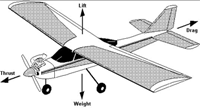
Forces acting on a flying plane
The force due to gravity, the weight of the plane, is opposed to the lift. The balance of the lift and the weight leads to the fact that the plane is maintained at constant altitude. To ensure that the plane continues to move forward, it is necessary to provide a force that compensates for the force called drag. This force is called the thrust. The thrust is generated by the system of propulsion of the planes, the engines. In the case of the flight at cruising speed, the role of the engine is thus to compensate for the force of drag, but not to make the plane climb. On the other hand, at the time of takeoff, the engine power will be used to bring the plane to the altitude of flight.
And what about sailplanes which do not have any engines? The lift of the sailplane is generally initiated by a plane which tows it until a certain altitude. Then, the sailplane is released and starts its autonomous flight. As it does not have any engine, it must follow a downward trajectory relative to the air to keep its speed. To avoid approaching the ground too quickly, it must find zones where the air follows an ascending direction. That enables him to continue its flight.
2.1 Lift and weight
Let’s start with a simple experiment. Take two paper sheets and hold them vertically. Take care to keep them 5 cm apart and blow between these sheets. What are you expecting to happen ? Begin the experiment after answering to this question only!
To keep the plane in flight at constant altitude, a force of lift must balance the force due to gravity (weight of the plane). This force of lift is generated by the airflow around the plane, in particular the flow of air around its wings.We now propose to explain how the air which flows around the wing of the plane manages to generate a force of lift directed upwards.
The two sheets will come closer to one another. Before blowing (in the absence of any air draught), the two sheets although motionless undergo on both sides the atmospheric pressure, which will be the same one on the two sides of the sheet. In a general way the atmospheric pressure is unperceivable. Let us carry out another experiment to feel the pressure which a fluid exerts on a body.
Put your hand inside a plastic bag, making sure that air is able to enter it. Plunge your hand (and the bag) in a water bucket.
What are you felling ?
The water will push-out the air contained in the bag and suddenly your hand will be surrounded by a uniform feeling due to the pressure exerted by the water on your hand.
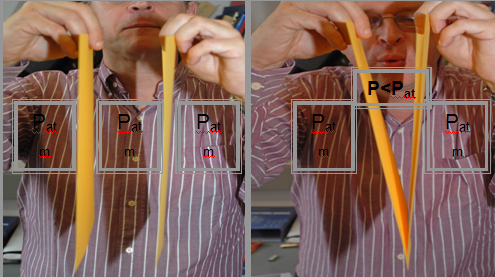
Having apprehended what is the pressure of a fluid when it is at rest, let’s examine what occurs as soon as this fluid is put in motion (in our experiment the air between the two sheets). In 1738, Daniel Bernoulli applied the principle of conservation of energy to the fluids and stated that the energy of the fluid is made up of energy due to its velocity - kinetic energy on one hand and on the other hand of energy due to its pressure - potential energy and by principle of conservation the sum of these two energies is constant. What in other term means that if the static pressure increases, velocity will only be able to decrease and vice versa.
What is the pressure ?
The most common definition of the pressure is of a force distributes over a surface . This pressure is exerted perpendicaly to the surface.
Unlike temperature, pressure is difficult to feel. The air exert a permanent pressure on our body and we do not feel it. The unpleasant feeling in our ears at takeoff and landing of the plane corresponds to a variation of pressure of the air in the aircraft. A fluid at rest will communicate to the bodies which it surrounds a pressure called static or hydrostatic.
The level of this pressure is function of the type of fluid which surrounds the body and in particialar of its density, height of fluid above the body and finally the value of the force of gravity.
In our experiment, when we blow between the two sheets, the velocity of the air is increasing between the sheets. As a result the pressure becomes lower than the atmospheric pressure and the sheets are attracted one by the other. An identical phenomenon occurs on the wing of an airplane when a flow of air is surrounding it. The shape of the wing, called profile, is characterized by a larger camber on the upper part and a sharp trailing edge. In addition, in flight, the wing of the plane is slightly pulled up, compared to the trajectory of the plane as one can see it on the figure opposite, one says that the wing is in small incidence.
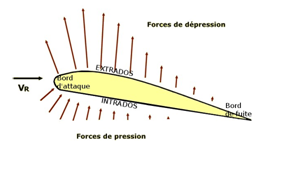
This particular shape and the incidence will generate a complex flow, characterized by higher speeds on the upper part of the wing. According to the principle of Bernoulli that we have just experimented, the pressure on the upper part of the wing of the airplane strongly decreases. This produces a force acting upwards: The lift. The role of the pilot is to adjust the speed of the plane and its incidence to be under conditions where the lift force balances the weight of the plane.
2.2 Propulsion : Drag and Thrust
Up to now we only considered the force of lift which requires the profile of wing. Actually, the air moving relatively to the surface of the wing and of the body of the airplane exerts a force of friction “which grows like the square” of the velocity. The faster the plane flies, the larger becomes this force of friction. This force of drag is opposed to the movement of the plane and will have to be compensated by the thrust provided by the engine. Do not forget that the planes are equipped with a fuselage, necessary to the transport of passengers and freight. Although it contributes by a small amount to the lift that is necessary to balance the weight of the aircraft, it increases in a significant way the resistance to advance. In addition, one takes advantage of their presence to attach to the fuselage various devices necessary to control the manoeuvres in flight and on the ground. They are the control and the high-lift control surfaces, empennages, landing gears,… They all contribute to increase the resistance to advance and are included in the total friction Drag.


Vortices at the tip of the wings
There also exists a force of drag known as induced drag, which is also opposed to the movement. This phenomenon occurs at the end of the wings. We saw that the upper part of the wing was in depression and the lower part of the wing was in overpressure. What occurs at the ends from the wing? The air tends to bypass the wing to move from the high to the low pressure areas. This will produce vortices at the tip of the wings. as seen on the opposite photograph. These vortices are strong energy consumers and they will generate a significant increase of the drag called the induced drag. The larger the lift, the more important is the induced drag.
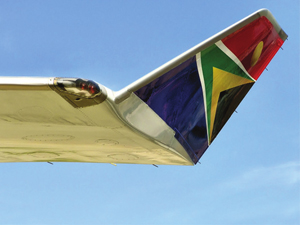
Winglet
It is easily understood that this drag will be smaller as the span of the wing of the airplane is larger. It is the case of the sailplanes which do not have engines and which must consume as little as possible of their potential energy to remain in the air for the longest possible time, On the planes of recent design, it is possible, thanks to the existence of new composite materials, to curve the ends of the wings. This device called Winglet and presented opposite on Laserjet 60, was very largely developed for business aircrafts and sailplane, and is know common on the new models of larger airplanes. The manufacturers of planes make constant efforts to reduce the consumption of the planes and to decrease their polluting emissions. This kind of device contributes to it.
The vortices generated by the tips of the wings also have an impact on the management of the air traffic. Indeed, these vortices have larger lifespan as the airplanes are heavier. These vortices disappear after a certain time under the effect of turbulence of the atmospheric wind and their natural dissipation. It will thus be necessary to wait for a sufficient time before the takeoff of the following plane to prevent that it could be destabilized by the vortices generated by the plane which has just taken off.
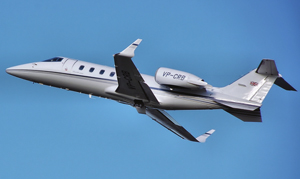
Winglets on Laserjet 60
Another element which generates drag is the landing gear. It is the reason why as soon as it is no longer necessary, it is retracted in the fuselage of the plane. During the approach of an airport, it is only lowered a short time before landing, when the airplane already significantly decelerated. Its deployment always generates a significant noise due to its disturbing effect on the flow around the plane.
The lift and the drag are related to the properties of physics and to the flows around the plane. It still is necessary to understand the system implemented to generate the force that maintains the plane in flight. This force of propulsion is generated by the engine of the airplane which is the fruit of long research projects and technological developments.
Before passing to the chapter describing the intricate working of the engines that propels the aircrafts, let’s make a small experiment. As shown on the sketch, it will consist in inflating a rubber balloon and to glue on it a plastic straw while keeping it blown. The straw is then slipped on a string that is taut between to fixed points. Put the balloon at the middle point of the string and let it go, allowing the air to escape. Watch the balloon. Comment the way the balloon goes.
As chapter 3 describes the principle of the engine of the airplanes, we will not return in the details. Let us introduce directly the principle of the propulsion by a very simple experiment.
The action of inflating the balloon is equivalent to increasing the pressure inside it above the ambient atmospheric pressure. As long as one maintains the fingers on the open end of the balloon, the forces due to overpressure are exerted on the wall of the balloon. At the opening of the end, since the pressure is more important inside than outside, the air will be put in motion to reach a balance of the pressures. A force is created as a consequence of the acceleration of the ejected air. By effect of reaction an opposite force is exerted on the balloon and the latter is propelled in opposite direction. This is an illustration of the well-known principle of action-reaction stated by Newton: “to each action (Force), will correspond an equal and opposite action”. This experiment illustrates the basic principle of the operation of the so-called jet airplanes.
2.3 Stability and manoeuvrability of the airplanes
Let us start by making the distinction between the stability and the manoeuvrability of the plane:
its manoeuvrability (its control) is ensured by the movements of moving parts of the plane making it possible to change its altitude, speed and direction.
its stability is its property to be maintained at its altitude and to resist a displacement (due to a gust of wind for example) and in the event of perturbation to develop a force restoring the initial flying conditions. Until now we only considered the case of the airplane in cruising flight at constant speed and altitude. In this case we saw that the plane is subjected to 4 balanced forces (Lift-Weight, Thrust-Drag) applied in its centre of gravity.
Manoeuvrability of the airplane
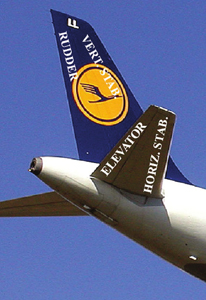
In addition to its displacement in horizontal direction, it is possible to consider side movements (rare for the planes) and rotation movements around the three axes. The movements (represented on the opposite figure) around the three axes are respectively called roll, pitch and yaw. These movements are characterized by rotations. Contrary to a car, a boat or a train, the planes are able to be driven according to the 3 axes. This movement occurs around the centre of gravity of the plane. The centre of gravity of the plane is the average position where the weight of the plane is applied. On the traditional planes, three types of devices are at the base of the control of the flight: the ailerons, the rudder and the horizontal stabilizers.
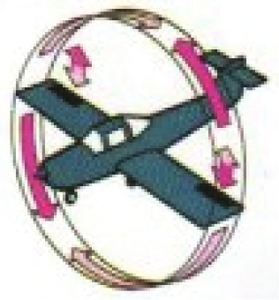
Roll
The ailerons are acting in opposition. This means that when the right-hand side aileron is raised, the left one drops, making it possible to control the movement of roll. This movement of roll is produced owing to the fact that on the side where the aileron is lowered, the lift of the wing will increase, whereas on the side where the aileron is raised the lift decreases. This creates an imbalance of the forces on the right and on the left of the wing and the plane is inclining on the right or left-hand side.
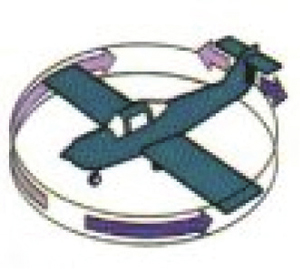
Yaw
The movement of yaw is a movement in which, when looking from the top, the nose of the plane moves from right to left (or left to right), and the plane turns around its centre of gravity in a horizontal plane. This movement of yaw is controlled by the rudder generally located in the tail of the plane. This device functions on the same principle as the rudder of a boat.
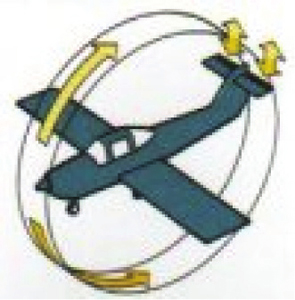
Pitching
The pitching of the plane is the movement where the plane turns around its centre of gravity and where the nose of the plane moves in a vertical plan (from top to bottom or upwards). Pitching is controlled thanks to horizontal stabilizers also located in the tail of the airplane.
Stability of the airplane
The gravity center ?
A fixed point in a material body through which the resultant force of gravitational attraction acts. The resultant of all forces or attractions produced by the Earth's gravity on a body constitutes its weight. This weight is considered to be concentrated at the center of gravity in mechanical studies of a rigid body. The location of the center of gravity for a body remains fixed in relation to the body regardless of the orientation of the body. If supported at its center of gravity, a body would remain balanced in its initial position.
We have just described how the pilot can voluntarily control the displacement of his plane. It remains to evoke the notion of the stability of the plane. One generally speaks about two types of concepts: static stability and dynamic stability. By definition, the plane is balanced (one also says trimmed) in flight when the resultants of the forces and the couples around the centre of gravity are null. A modification of one of the parameters of flight caused either by an atmospheric disturbance (wind, turbulence), or by an action on the controls, modifies these forces and moments temporarily. If their resultants tend to bring back the apparatus towards a position of balance, the aerodyne is regarded as statically stable. If not, it is statically unstable. It is important to note that this definition implies a tendency. One makes also the distinction between stability with free controls or controls blocked, according to whether the controls can move freely or that they are maintained in a fixed position during the movement which follows the disturbance. Before takeoff, the pilot will have to adjust various controls to ensure this stability according to the load of the airplane.
